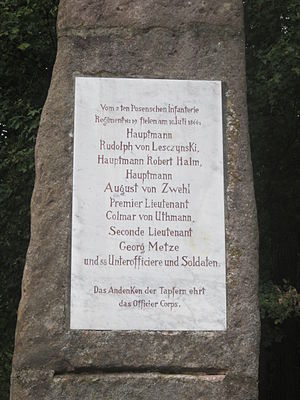Monument to the fallen in 1866 (Winkels)
The grave monument in Winkels is a memorial to the soldiers of the 2nd Posen Infantry Regiment No. 19 who died in the German War in 1866 on the battlefield near Bad Kissingen .
The memorial is located near the exit from Winkels towards the neighboring community of Nüdlingen . It belongs to the Bad Kissingen architectural monuments and is registered under the number D-6-72-114-392 in the Bavarian list of monuments .
history
Shortly after the German War, a Prussian Kissinger spa guest campaigned for a mass grave for the fallen soldiers of the infantry regiment stationed in Görlitz and Lauban in Silesia. The district administrator got in touch with the community of Winkels and suggested that Winkels take care of the grave in exchange for a donation of 25 guilders for the Winkels poor fund. On the anniversaries of the battle, a moss wreath was to be laid on the grave, which was to be tended by the mayor; both should be financed with the interest of 30 kreuzers .
On September 28, 1866, 50 guilders were transferred to the Kissing sculptor Michael Arnold "for a temporary memorial stone". Michael Arnold also mentioned the royal Prussian sergeant from Rex from Frankenhausen in Thuringia , who bought the grave site on March 10, 1867 for 30 Thaler for 50 years. In connection with the question of the performing artist, Heimatpfleger Werner Eberth described the memorial as "simple craftsmanship that any better stonemason could have provided".
According to information from the mayor of Winkels on January 8, 1867, Joseph Behr, the owner of the property in question, demanded 15 gulden as payment. On May 24, 1867, Behr sold the 1200 square foot area for 25 guilders to Hermann von Barczko, captain of the Prussian Infantry Regiment 19, whose rights and duties were taken over by the bath commissioner on December 21, 1867. Thus, the state spa administration is responsible for the complex today.
The memorial was mentioned in the report on the German War written by the writer Theodor Fontane , but without naming the artist who carried it out.
On a postcard from around 1900 in Nüdlingen, the grave complex, in which, according to the names of those who were buried, victims of Polish descent were buried, bears the name “Poland Monument”. The officers who bear German names except for the most senior officer, Captain Rudolph von Leszczynski, are an exception. Around 1935, in keeping with the spirit of the times, the monument was viewed as a “Prussian monument”.
literature
- Werner Eberth : Michael Arnold, a sculptor of the late classicism . Theresienbrunnen-Verlag, Bad Kissingen 2001, pp. 56–58.
Web links
Individual evidence
- ^ Werner Eberth: Michael Arnold. A sculptor of the late classicism . Theresienbrunnen-Verlag, Bad Kissingen 2001, p. 56.
Coordinates: 50 ° 12 ′ 55.5 ″ N , 10 ° 6 ′ 22.5 ″ E

